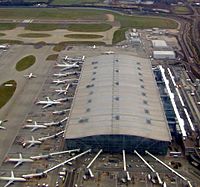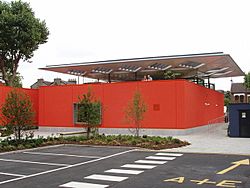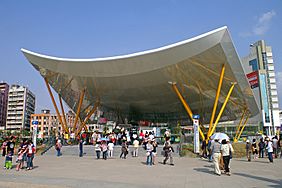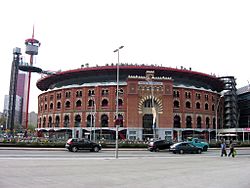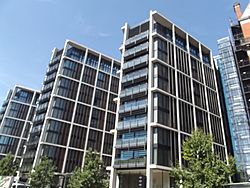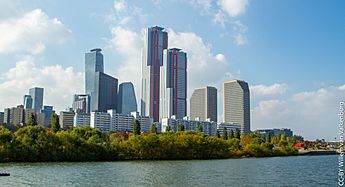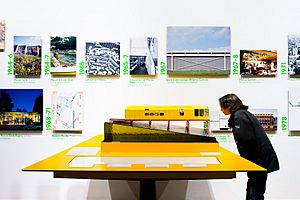Richard Rogers facts for kids
Quick facts for kids
The Lord Rogers of Riverside
|
|
|---|---|

Rogers in 2013
|
|
| Born |
Richard George Rogers
23 July 1933 Florence, Tuscany, Italy
|
| Died | 18 December 2021 (aged 88) London, England
|
| Nationality | British and Italian |
| Alma mater |
|
| Occupation | Architect |
| Spouse(s) | |
| Children | 5, including Roo |
| Awards |
|
| Practice | Rogers Stirk Harbour + Partners (2007–2020) |
| Buildings |
|
| Projects |
|
Richard George Rogers, Baron Rogers of Riverside, CH, FRIBA, FCSD, FREng, RA (23 July 1933 – 18 December 2021) was a British-Italian architect noted for his modernist and functionalist designs in high-tech architecture. He was a senior partner at Rogers Stirk Harbour + Partners, previously known as the Richard Rogers Partnership, until June 2020.
Rogers was perhaps best known for his work on the Pompidou Centre in Paris, the Lloyd's building and Millennium Dome, both in London, the Senedd building, in Cardiff, and the European Court of Human Rights building, in Strasbourg. He was awarded the RIBA Gold Medal, the Thomas Jefferson Medal, the RIBA Stirling Prize, the Minerva Medal, and the Pritzker Prize.
Early life and career
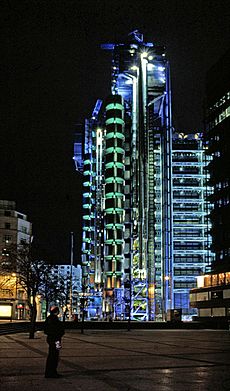
Richard Rogers was born in Florence, Tuscany, in 1933 into an Anglo-Italian family. His father, William Nino Rogers (1906–1993), was Jewish, and was the cousin of Italian Jewish architect Ernesto Nathan Rogers. His Jewish ancestors moved from Sunderland to Venice in about 1800, later settling in Trieste, Milan and Florence. In October 1938, William Nino Rogers came back to England, having fled Fascist Italy and anti-Jewish laws under Mussolini.
Upon moving to England, Richard Rogers went to St John's School, Leatherhead. Rogers did not excel academically, which made him believe that he was "stupid because he could not read or memorise his school work" and as a consequence, he said, he became "very depressed". He couldn't read until he was 11, and it was not until after he had his first child that Rogers realised he was dyslexic. After leaving St Johns School, he undertook a foundation course at Epsom School of Art (now the University for the Creative Arts) before going into National Service between 1951 and 1953.
He then attended the Architectural Association School of Architecture in London, where he gained the Architectural Association's Diploma (AA Dipl) from 1954 until 1959, subsequently graduating with a master's degree (M Arch) from the Yale School of Architecture in 1962 on a Fulbright Scholarship. While studying at Yale, Rogers met fellow architecture student Norman Foster and planning student Su Brumwell.
After leaving Yale he joined Skidmore, Owings & Merrill in New York City. On returning to England in 1963, he, Norman Foster and Brumwell set up architectural practice as Team 4 with Wendy Cheesman (Brumwell later married Rogers, Cheesman married Foster). Rogers and Foster earned a reputation for what was later termed by the media high-tech architecture.
By 1967, Team 4 had split up, but Rogers continued to collaborate with Su Rogers, along with John Young and Laurie Abbott. In early 1968 he was commissioned to design a house and studio for Humphrey Spender near Maldon, Essex, a glass cube framed with I-beams. He continued to develop his ideas of prefabrication and structural simplicity to design a Wimbledon house for his parents. This was based on ideas from his conceptual Zip-Up House.
Rogers subsequently joined forces with Italian architect Renzo Piano, a partnership that was to prove fruitful. His career leapt forward when he, Piano and Gianfranco Franchini won the design competition for the Pompidou Centre in July 1971, alongside a team from Ove Arup that included Irish engineer Peter Rice.
Later career
After working with Piano, Rogers established the Richard Rogers Partnership along with Marco Goldschmied, Mike Davies, and John Young in 1977. This became Rogers Stirk Harbour + Partners in 2007. The firm maintains offices in London, Shanghai, and Sydney.
Rogers devoted much of his later career to wider issues surrounding architecture, urbanism, sustainability, and the ways in which cities are used. One early illustration of his thinking was an exhibition at the Royal Academy in 1986, entitled "London As It Could Be", which also featured the work of James Stirling and Rogers' former partner Norman Foster. This exhibition made public a series of proposals for transforming a large area of central London, subsequently dismissed as impractical by the city's authorities.

In 1995, he became the first architect to deliver the BBC's annual Reith Lectures. This series of five talks, titled Sustainable City, were later adapted into the book Cities for a Small Planet (Faber and Faber: London 1997, ISBN: 0-571-17993-2). The BBC made these lectures available to the public for download in July 2011.
In 1998, he set up the Urban Task Force at the invitation of the British government, to help identify causes of urban decline and establish a vision of safety, vitality, and beauty for Britain's cities. This work resulted in a white paper, Towards an Urban Renaissance, outlining recommendations for future city designers. Rogers also served for several years as chair of the Greater London Authority panel for Architecture and Urbanism. He was chair of the board of Trustees of The Architecture Foundation.
From 2001 to 2008, he was chief advisor on architecture and urbanism to the then Mayor of London Ken Livingstone. In 2008, he was asked to continue on in his role as an advisor by the then new mayor Boris Johnson. He stood down from the post in October 2009. Rogers also served as an advisor to two mayors of Barcelona on urban strategies.
Amidst this extra-curricular activity, Rogers continued to create controversial and iconic works. Perhaps the most famous of these, the Millennium Dome, was designed by the Rogers practice in conjunction with engineering firm Buro Happold and completed in 1999. It was the subject of fierce political and public debate over the cost and contents of the exhibition it contained; the building itself cost £43 million.
In May 2006, Rogers' practice was chosen as the architect of Tower 3 of the new World Trade Center in New York City, replacing the old World Trade Center which was destroyed in the September 11 attacks.
Rogers resigned his directorship of Rogers Stirk Harbour + Partners on 30 June 2020. The Rogers name will be removed from the practice by 2022 as the founding constitution requires.
Selected projects
Team 4
- Creek Vean, Cornwall, UK (1963–1966)
- Reliance Controls factory, Swindon, UK (1967)
- Jaffe House (also known as Skybreak House), Humphrey Spender's house, Maldon, UK (1965–1966)
- Wates Housing, Coulsdon, Surrey, UK (1965)
- Murray Mews, Camden, London, UK (1966)
Richard and Su Rogers Architects (with John Young and Laurie Abbott)
- 22 Parkside (Dr. Nino and Dada Rogers' house), Wimbledon, London, UK (1967)
- Zip-Up House (1967–69)
Piano + Rogers
- Universal Oil Products, Tadworth, UK (1969–1974)
- B&B Italia headquarters, Como, Italy (1972–1973)
- Pompidou Centre, Paris, France (1971–77)
- IRCAM, Paris, France (1971–1977)
- PA Consulting Group's Research Laboratory, Melbourn, UK (1976–1983)
The Richard Rogers Partnership

- Lloyd's building, London, UK (1978–84)
- Inmos microprocessor factory, Newport, Wales, UK (1980–1982)
- Old Billingsgate Market, London, UK (1985–1988)
- Paternoster Square, London, UK (1987)
- The River Café, London, UK (1987)
- Reuters Data Centre, London, UK (1987–1992)
- Kabuki-cho Tower, Tokyo, Japan (1987–1993)
- Linn Products, Waterfoot, Glasgow (1988)
- Antwerp Law Courts, Belgium (2000–2006)
- Marseille Provence Airport, Marignane, France (1989–1992)
- Channel 4 Headquarters, London, UK (1990–1994)
- European Court of Human Rights building, Strasbourg, France, 1995
- 88 Wood Street, London, UK (1990–1999)
- Palais de Justice de Bordeaux, Bordeaux, France (1993–1999)
- Lloyd's Register building, London, UK (1995–1999)
- Millennium Dome, London, UK (1996–1999)
- Broadwick House, London, UK (1996–2000)
- Paddington Waterside, London, UK (1999–2004)
- Mossbourne Community Academy, London, UK (2002–2004)
- Senedd building, Cardiff, Wales (1999–2005)
- Adolfo Suárez-Madrid Barajas Airport terminals 4 and 4S, Madrid, Spain (2004)
- Hesperia Tower, Barcelona, Spain (2005)
Rogers Stirk Harbour + Partners
- Heathrow Terminal 5, London, UK (1989–2008)
- Las Arenas, Barcelona, Spain (1999–2011)
- Maggie's Centre, London, UK (2001–2008)
- Central Park Station (R9), Kaohsiung Mass Rapid Transit system, Kaohsiung City, Taiwan (2003–2007)
- Three World Trade Center, New York City (2006–2018)
- British Museum, World Conservation and Exhibitions Centre, London, UK (2007–2014)
- One Hyde Park, London (2007–2010)
- Atrio Towers, Bogotá (2008–)
- Santa Maria del Pianto Underground Station, Naples, Italy (2006–)
- NEO Bankside, London, UK (2012)
- 33 Park Row, New York, USA (2021)
- 122 Leadenhall Street, also known as the Cheesegrater, London (2000–2014)
- Greater Paris / Grand Paris, France (2008–2013)
- Oxley Woods, Milton Keynes, UK (2004–2010)
- St. Lawrence Market North Revitalization, Toronto, Canada (2010–) with Adamson Associates
- Y:Cube, London (2013–2015)
- International Quarter London, London (2014-ongoing)
- Taoyuan International Airport T3, Taipei, Taiwan (2015-ongoing)
- International Towers Sydney, Barangaroo, Sydney (2010–2016)
- 8 Chifly, Sydney, Australia (2005–2013)
- PLACE / Ladywell, London, UK (2014–2016)
- Parc1 Tower, Seoul, South Korea (2008–2020)
Criticisms
Like Le Corbusier, the designs of some of Rogers's buildings have not proved as functionally efficient as claimed, suffering from leaks and maintenance problems. The Lloyds Buildings's much-vaunted design innovation of having the service pipes, etc outside the walls, in fact led to such costs caused by weathering and maintenance that Lloyds considered vacating the building in 2014. Lloyd's former chief executive Richard Ward stated: "There is a fundamental problem with this building. Everything is exposed to the elements, and that makes it very costly."
In 2014 Rogers faced a £5m legal claim over problems at the Oxley Woods estate designed by the firm. Residents complained of water seepage through cladding panels and windows on the prefabricated terraced housing.
Personal life
Rogers was married to Ruth Rogers, chef and owner of The River Café restaurant in west London. They had two sons together, Roo and Bo (deceased 2011). Rogers also had three sons, Ben, Zad and Ab, from his first marriage to Su Brumwell. He had fourteen grandchildren and a younger brother, Peter William Rogers, a property developer and co-founder of Stanhope. In 2015, he was named one of the "50 best-dressed British men" by GQ magazine.
He died in London on 18 December 2021, at the age of 88.
Honours and awards
Rogers was knighted in 1991 by Queen Elizabeth II. He was created Baron Rogers of Riverside, of Chelsea in the Royal Borough of Kensington and Chelsea on 17 October 1996. He sat as a Labour peer in the House of Lords; having not attended a proceeding in the 2019–21 session, his membership expired on 11 May 2021. Rogers was appointed a Member of the Order of the Companions of Honour (CH) in the 2008 Birthday Honours list. However, he was a republican.
Rogers was awarded the RIBA Royal Gold Medal in 1985. He was twice honoured by France, first as a Chevalier, L'Ordre National de la Légion d'honneur in 1986, and later as an Officier de l'Ordre des Arts et des Lettres in 1995. He received a Golden Lion for Lifetime Achievement at the 10th Mostra di Architettura di Venezia. In 2006, the Richard Rogers Partnership was awarded the Stirling Prize for Terminal 4 of Barajas Airport, and again in 2009 for Maggie's Centre in London. Rogers won the Gold Medal for Architecture at the National Eisteddfod of Wales of 2006 for his work on the Senedd building of the Senedd (Welsh Parliament). He was also appointed an Honorary Fellow of the Royal Academy of Engineering in 2005. In 2007 Rogers was made Laureate of the Pritzker Architecture Prize – architecture's highest honour. He was awarded the Minerva Medal by the Chartered Society of Designers in the same year. In 2012, Rogers was among the British cultural icons selected by artist Sir Peter Blake to appear in a new version of his most famous artwork – the Beatles' Sgt. Pepper's Lonely Hearts Club Band album cover – to celebrate the British cultural figures of the last six decades.
Rogers was awarded honorary degrees from several universities, including Alfonso X El Sabio University in Madrid, Oxford Brookes University, the University of Kent, the Czech Technical University in Prague and the Open University. In 1994, he was awarded an Honorary Degree (Doctor of Science) by the University of Bath.
See also
 In Spanish: Richard Rogers para niños
In Spanish: Richard Rogers para niños




